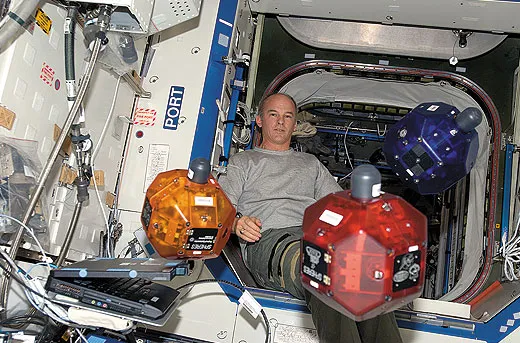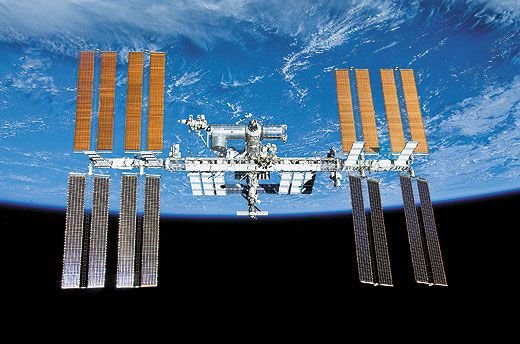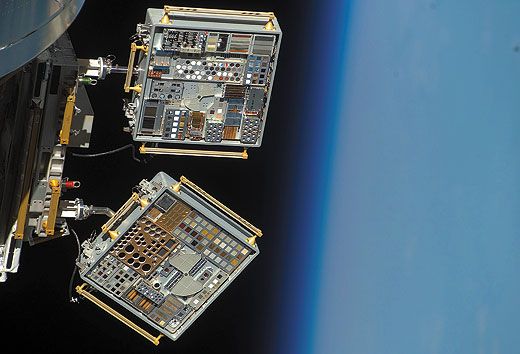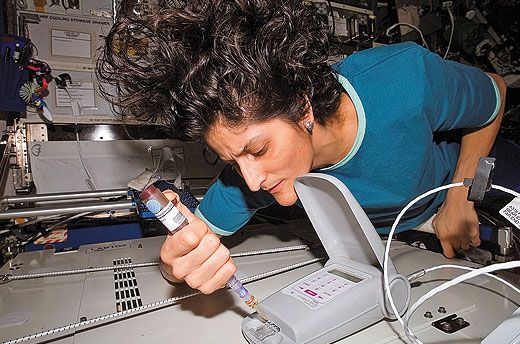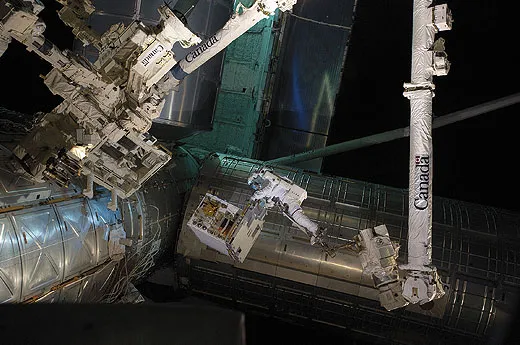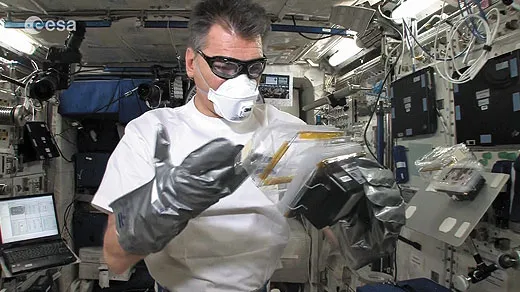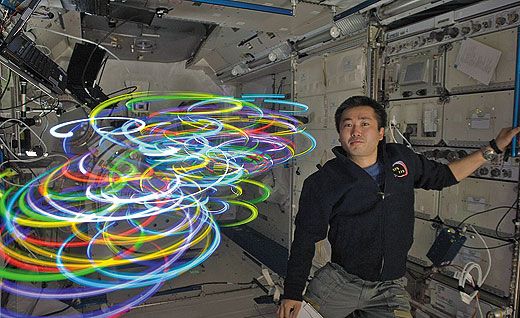The World’s Highest Laboratory
The space station’s finished. Now what?
/https://tf-cmsv2-smithsonianmag-media.s3.amazonaws.com/filer/World_Highest_Lab_03012012_1_FLASH.jpg)
After 13 years of hauling hundreds of pieces into space and almost 200 spacewalks to connect them, NASA and its 14 international partners have opened the biggest—and costliest—scientific laboratory ever to orbit Earth. NASA estimates the United States alone has put in $48.5 billion. Now the world is waiting to see whether the science conducted aboard the International Space Station will be as extraordinary as its engineering.
Weighing in at 450 tons, the station has the pressurized volume of one and a half Boeing 747s and boasts an acre of solar arrays, which generate 700,000 kilowatt-hours of electricity a year, enough to power 50 homes. NASA will use its share of that capability to learn about space travel, space technology, and the effects of prolonged spaceflight on the human body—all areas of prime interest in plans to eventually send astronauts to Mars.
But there’s capacity left over, and U.S. scientists who want to fly their experiments in space no longer have to go through either NASA or one of the international partners to make that happen. Now there’s a new point of entry into the U.S. Destiny lab: through the non-profit Center for the Advancement of Science in Space (CASIS). Last August, NASA signed an agreement with the center for it to develop and manage about half of the U.S. share of the station, which Congress in 2005 designated as a National Laboratory, the 17th U.S. facility so named. Filling it with new experiments is “not going to happen instantaneously,” says NASA’s Mark Uhran, director of the International Space Station division and the man in charge of the transition from station construction to station use. But with the CASIS agreement in place, he says, NASA “looks forward to a gradual and consistent expansion” of research aboard the ISS.
The research NASA is now conducting—through collaborative agreements with such organizations as the Department of Agriculture, the National Institutes of Health, and the Defense Advanced Research Projects Agency—advances NASA’s mission in space exploration, says Uhran. What CASIS will oversee in the National Laboratory, he says, “will have both peer-reviewed basic research and market research with private firms.”
With one important distinction: “The idea is to develop products to help benefit Earth,” says the center’s executive director, Jeanne Becker, a cell biologist whose experiments have flown on the space shuttle. “The agenda will be multidisciplinary, but the emphasis will be on using the space environment to make life better here.”
The center, located in the Space Life Sciences Laboratory at Florida’s Kennedy Space Center, will receive from NASA $15 million per year for the next 10 years, and will both make its own grants and oversee installation of other experiments that have their own resources. Priorities in such fields as biomedicine, life sciences, and material sciences will be set by a 15-member board, with members serving for three years, Becker says. The center plans to issue its first solicitation for research proposals this fall.
WITH THE STATION OPEN for business, both traditional users, like NASA scientists and their partners, and innovators from academia or industry have begun planning expanded research programs.
John Charles, chief scientist for NASA’s Human Research Program, has been waiting since 2003 to use the station as an analog for a spacecraft transit to Mars. “It’s very high-fidelity,” he says. “You have isolation, weightlessness, canned food, risk of decompression, and at the same time you’re trying to do meaningful work.” Charles and his team have begun crafting a 2013 project that will ask station astronauts to do a dozen ordinary tasks while coping with delays of several minutes in their communications with mission control. Radio transmissions from Earth would take more than 20 minutes to reach astronauts on Mars.
“We don’t want to spring the delay on them suddenly and see what happens,” says Charles. “We want to spend a lot of time thinking about texting, instant messaging, and any other way astronauts can have a written record to help them work around the delays. Then we’ll see.”
Among the innovators is the Massachusetts Institute of Technology’s Space Systems Laboratory, with its unique SPHERES experiment. Few tools better advertise the station’s capabilities than SPHERES. Three soccer ball-size spheres—duododecahedrons, actually, formed by 24 flat polygons—float like large golden orbs in a Harry Potter-like game whenever they are released inside the station. Each ball has carbon dioxide thrusters that allow it to move up and down, side to side, in a circle, a spiral, you name it—as long as you program it with the right software. You can use one ball as if it were a single spacecraft, two if you want to dock them, or all three if you’re interested in formation flight. Astronauts can joystick them from a laptop, or the balls can be programmed beforehand and simply put to work.
SPHERES—for Synchronized Position Hold, Engage, Reorient, Experimental Satellites—is the brainchild of MIT’s David Miller and has been aboard the station since 2006. It is used by the Department of Defense, NASA, and private aerospace companies to assess the feasibility of new maneuvering techniques in space by testing them in microgravity—but in miniature. Can a spacecraft dock with a tumbling piece of space junk? Yes. Simply program one sphere to roll around and simulate a derelict satellite. Then program another to dock with it—without crashing—and bring it down to Earth’s atmosphere, where it can burn up.
“We don’t tell you what kind of spacecraft to build,” says MIT aeronautical engineer Alvar Saenz Otero, the experiment’s chief scientist. “We build the software that makes it possible to do what you want to do. Nobody had ever docked in space with a tumbling object before.” A tool for today’s space age, SPHERES is able to provide practical demonstrations of how engineering theory works in actual microgravity.
Beyond its focus on Mars-applicable technologies, NASA will be looking for more innovations like SPHERES, a project that will grow more useful as time passes. Using the SPHERES-tested software, mission planners may one day program spacecraft to dock on their own. Controllers in the future can fly a suite of telescopes in formation, shifting them and re-pointing them as perspectives on the cosmos change. As interest mounts in servicing satellites in space or de-orbiting dead spacecraft, SPHERES docking techniques can come into play. And as the threat of collisions with orbital debris increases, SPHERES technology can enable satellites to sense debris and stay out of harm’s way.
Also in place is the joint NASA-Canadian Space Agency Robotic Refueling Mission, in which a simulated satellite fuel module serves as a prop in practicing on-site refueling. Station crews will use the Canadian-built Dextre robotic arm to manipulate a set of special tools to tear off the insulation protecting the fuel tank (located on the outside of the station), unscrew the cap, and pump in a new load of (simulated) hydrazine fuel. The experiment’s operations began last September and will continue through 2013.
“This is a bottom-line benefit,” says Frank Cepollina, project manager for the Satellite Servicing Capabilities Office at NASA’s Goddard Space Flight Center in Maryland. “If you had this capability, you could extend the use of a satellite by refueling it, repairing it, or repositioning it, and by demonstrating it in space, we can go a long way toward removing the reluctance of commercial companies to do this kind of thing.”
Another path-breaking experiment is a forerunner to the type of research that CASIS will review. NASA is sponsoring University of Florida horticulturalist Wagner Vendrame, who is sending tissue samples from a wild, tropical, coffee-tree-size shrub called jatropha to be grown on the station. Identical sets of samples are being grown on Earth.
Scientists are interested in jatropha because it produces a fruit whose seeds yield an astonishingly pure oil that is an ideal source of biodiesel. “The problem is we don’t have commercial cultivars yet,” Vendrame says. “It’s a wild species and it’s like somebody found the first corn plant.” Jatropha may be a source of revenue for growers in the state of Florida, which, worried about winter freezes, citrus canker, and other threats to its groves, is looking for a profitable alternative to oranges and grapefruit. But jatropha’s early promise faded because of improper cultivation practices; in addition, there are too many varieties of the plant with too few desirable characteristics.
Vendrame is using his best plants on the station, and comparing the results with his ground samples, hoping to more quickly identify genes that produce the most oil. In traditional harvesting on Earth, many generations must be produced before a useful cultivar can be found. “Microgravity might accelerate the process,” he says. “We may be able to save 10 years.”
The station’s international partners are also planning Earth-focused activities. The Canada-based company UrtheCast has an agreement with the Russian space agency, Roscosmos, and aerospace company RSC Energia to launch and install a pair of Earth-observation cameras on the Russian side of the station this year. One camera will be fixed in place and point straight down, while a second, boom-mounted camera will be movable to focus on details, says UrtheCast president Scott Larson. Both feeds will be streamed on the Internet for free, but Larson says the company expects to make money by selling its raw data to other firms and organizations, and through advertising.
The European Space Agency has steadily expanded its station science agenda since the launch and installation of its Columbus laboratory in 2008. Columbus now has 150 projects under way and expects to move into experiments lasting much longer. “For us, it’s a steady evolution,” says Martin Zell, chief of ESA’s Astronauts and ISS Utilisation Department. “In our research into plant biology, immunology, neurophysiology, fluids and materials research, we are implementing several experiments where the new objectives are based on the results of previous experiments.” Like NASA, ESA is moving into studying the effects of prolonged spaceflight on the body.
In the third lab, the Japanese-built Kibo, experiments are focused on space medicine, biology, Earth observations, materials production, biotechnology, and communications research. The Japanese space agency, JAXA, has selected 19 candidate experiments to fly in 2012—15 in life sciences and four in materials sciences. Some of the more exotic involve studying the effects of microgravity on zebrafish, mouse embryos, and mammalian reproductive cells.
EVIDENCE IS MOUNTING that the odd behavior of cells and microbes in space might lead to shortcuts in fields as diverse as disease pathology and crop development. Because this is one area where research in microgravity might translate into useful science on Earth, biological experiments will be a key focus of the National Laboratory. Experiments on both the shuttle and the station have shown that microgravity alters gene expression in microbes and plant and animal cells, and researchers want to continue to use the station to gain insights into these changes.
Much of NASA’s optimism for the National Laboratory springs from an unusual 2006 experiment initiated by microbiologist Cheryl Nickerson of Arizona State University’s Biodesign Institute and NASA’s Mark Ott, a microbiologist at the Johnson Space Center in Houston. Ott had noted that astronauts’ immune systems appeared to weaken during spaceflight, “and I asked him whether we knew anything about the effects of spaceflight on microbial pathogens,” Nickerson recalls. “He said ‘Not really.’ ” It was not a farfetched question. Biologists have long known that microbes have an uncanny ability to thrive in extreme environments, such as ocean floor vents, cave ponds, or toxic waste dumps. Why not in space?
So Nickerson and Ott decided to fly cultures of salmonella bacteria aboard space shuttle Atlantis to see what happened. The cultures were placed in individual chambers that the shuttle crew activated for 24 hours. Back on Earth, the team tested the samples and found that, in space, several key salmonella genes manifested themselves differently, and that a particular protein acted as a master switch to turn up the infectivity of the bacteria. The group validated the work on another shuttle mission, showing that they could turn off the infectivity by manipulating salts in the cultures.
Similar research was done by Astrogenetix, a company in Austin, Texas, which knocked out several salmonella genes and flew those cultures in worms on the shuttle. In doing so, they took away the bacteria’s infective power. The company plans to submit its findings to the Food and Drug Administration to get the altered bacteria approved as an investigational new drug, with the goal of creating a vaccine.
NIH, a longtime NASA collaborator, is interested in this biomedical research and has begun a grant program seeking applications from a broad range of disciplines. “The idea is to increase the use of the space station for research that applies to a much broader purpose—human health,” says Joan McGowan, director of NIH’s division of musculoskeletal diseases, who is overseeing the competition.
Arizona State’s Nickerson, for one, is an applicant, and already has an agreement with NASA to test salmonella in space as a carrier for a pneumonia vaccine that is under development. “Gravity may mask changes in gene expression that regulate a live vaccine,” she says. “Our hypothesis is that spaceflight will make our vaccine stronger. We want to observe these changes in space, then tweak the vaccine to get a better strain.”
Another project, directed by Harvard Medical School assistant professor Paola Divieti Pajevic, one of the first NIH grantees, will grow bone cells in space to find genes that sense gravity and regulate bone mass. “By either stimulating genes or blocking genes, we can perhaps prevent bone loss or stimulate bone growth in patients on the ground,” she says. “The ISS would be the proof of principle that our lab model is working.”
Under the terms of the NIH program, Divieti Pajevic has two years to prepare the experiment before flying it. NIH and NASA have asked the team to design the project so it keeps astronaut time to a minimum, and to make sure there is a way to provide electricity to the payload during launch and docking. Another limitation, she notes, is that “you only get one shot.” If the experiment does not work immediately, there’s no tweaking for second chances.
MANY IN THE AEROSPACE community are generally upbeat about the station’s possibilities, noting that it already has weathered hard times. Station research suffered a blow during the George W. Bush administration, when the budget for human spaceflight was focused on a return to the moon and eventually a manned flight to Mars. Station science was further hurt in the aftermath of the 2003 Columbia disaster, when the shuttles were grounded for more than three years. “Life science was cut by 90 percent,” says former astronaut Jeffrey Hoffman, a professor of aerospace engineering at MIT. “Engineering technology research budgets were decimated.”
Now, though, “there’s a commitment to actually implement the National Lab,” says Hoffman. Even so, he cautions, “the challenge of turning the space station into a working, efficient laboratory is going to be every bit as difficult as building it in the first place. There are a lot of people running the space station who want to maximize the return. Inherent in the NASA system are a huge number of impediments thrown in the way, and when you add it all together, it’s a lot harder to use the space station than it probably needs to be.”
NASA and other agencies, he says, will have to find the money to fund the research, and astronauts who in the past spent much of their time on maintenance will have to make time to work on science—whether for NASA or CASIS. Scientists on the ground will have to be able to communicate more easily with astronauts aloft instead of funneling every word through NASA interlocutors. “There is a lot of bureaucracy,” Hoffman says.
For one thing, the selection process is rigorous—some would say too much so. “You can’t just show up at NASA headquarters and say ‘Here’s a gizmo. I want to stick this on the station,’ ” says Scott Dulchavsky, chairman of surgery at the Henry Ford Health System in Detroit, Michigan. “There has to be an avenue of cooperation.” His NASA-sponsored experiment on telemedicine—using the only medical imaging device aboard the station, an ultrasound machine—has flown twice and is scheduled to fly again this year or in 2014. Using software Dulchavsky’s team developed, crew members use the station’s laptop to quickly learn how to use the ultrasound to diagnose such ailments as a collapsed lung or a broken bone. (Normally, it takes 200 hours to learn how to use an ultrasound; Dulchavsky compressed that to two hours on the ground with 30-minute refresher training in space on the laptop.)
The results—the crew could quickly and efficiently learn to operate the ultrasound—encouraged Dulchavsky to work with the United Nations and the Web site winfocus.org to make the software and ultrasound available around the world. “We’re now in 45 countries,” he says, and used by everyone from Olympic trainers to remote villagers in Africa, along with most trauma centers in the United States.
One of the biggest challenges for scientists in using the station is learning how to coordinate with NASA hierarchy. “People don’t realize how damn tough it is to get something certified” for space, says Dulchavsky. “You have to go through a number of safety checks and modifications so it’ll actually work in microgravity. It’s a different language that you have to speak.” NASA, he adds, is looking at ways to help smooth the process. “It’s on their radar screen, but it’s not solved yet. The brilliant scientists that we want to use this facility, it’s not their sweet spot to think about what’s an integration partner. It should not be their worry to have to figure out how to fly something. It ought to be us, whether it’s NASA or Wyle Labs [his co-investigator on the ultrasound experiment] or some other entity.”
The process should be less daunting now that CASIS is getting involved, says Becker, who points out that, in years past, station science had to be worked around construction. “I wouldn’t say that NASA was not encouraging scientists,” she says. “It was just that the allowable mass and volume constraints were dictated by what kinds of pieces were needed for the station’s construction. Now that we have the opportunity to have robust science performed on the station, it’s time to use it.”
Whether the experiment is overseen by NASA or CASIS, scientists now have more time to prepare their research proposals. The Obama administration, betting that the station can fulfill its scientific promise, has extended its mission from 2016 to at least 2020.
Guy Gugliotta is a science writer in Pelham, New York.
